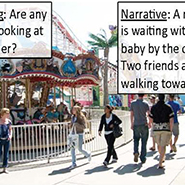Existing approaches to labeling images and videos with natural-language sentences generate either one sentence or a collection of unrelated sentences. Humans, however, produce a coherent set of sentences, which reference each other and describe the salient activities and relationships being depicted. In keeping with the CBMM goal of understanding human intelligence, we are devising new approaches that can reproduce this behavior. The goal of this project is to produce rich descriptions of sequences of events, static and changing spatial relationships, properties of objects, and other features.
Vision and Language
 The goal of this research is to combine vision with aspects of language and social cognition to obtain complex knowledge about the environment. To obtain a full understanding of visual scenes, computational models should be able to extract from the scene any meaningful information that a human observer can extract about actions, agents, goals, scenes and object configurations, social interactions, and more. We refer to this as the ‘Turing test for vision,’ i.e., the ability of a machine to use vision to answer a large and flexible set of queries about objects and agents in an image in a human-like manner. Queries might be about objects, their parts, and spatial relations between objects, actions, goals, and interactions. Understanding queries and formulating answers requires interactions between vision and natural language. Interpreting goals and interactions requires connections between vision and social cognition. Answering queries also requires task-dependent processing, i.e., different visual processes to achieve different goals.
The goal of this research is to combine vision with aspects of language and social cognition to obtain complex knowledge about the environment. To obtain a full understanding of visual scenes, computational models should be able to extract from the scene any meaningful information that a human observer can extract about actions, agents, goals, scenes and object configurations, social interactions, and more. We refer to this as the ‘Turing test for vision,’ i.e., the ability of a machine to use vision to answer a large and flexible set of queries about objects and agents in an image in a human-like manner. Queries might be about objects, their parts, and spatial relations between objects, actions, goals, and interactions. Understanding queries and formulating answers requires interactions between vision and natural language. Interpreting goals and interactions requires connections between vision and social cognition. Answering queries also requires task-dependent processing, i.e., different visual processes to achieve different goals.

